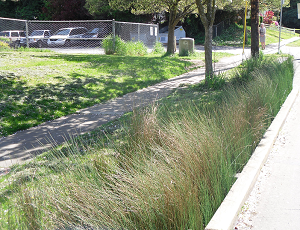
October 19, 2015, by Blue-Green team
Sustainable drainage systems: helping people live with water
Sustainable urban drainage systems, or SuDS, are increasingly acknowledged as an effective means of surface water management that ‘makes space for water‘ and utilises surface water as a resource rather than a nuisance. The increasing number of SuDS installations has led to potential shifts in the perception and attitudes towards these assets. This study, recently published in the Proceedings of the Institution of Civil Engineers (ICE) – Water Management, and led by Dr Glyn Everett (Department of Architecture and Built Environment, University of the West of England), compares the attitudes and awareness of SuDS in communities where assets have been in place for some time in the USA (focussing on Portland, Oregon) and the UK (Bristol). The key finding was that there is a distinct lack of understanding about the existence and function of SuDS in both the UK and the US. It is suggested that greater levels of consultation during the planning and installation phases, followed by ongoing dialogue between local residents and SuDS practitioners/institutional representatives, could help increase awareness, promote understanding and create greater satisfaction with these water management assets. This could ultimately lead to behavioural change and increased community resilience to flooding (and drought).
How SuDS are perceived by communities is a significant concern as such perceptions will influence the ‘felt’ benefits and costs of the SuDS assets, peoples willingness to contribute towards maintenance costs and stewardship initiatives, how people interact and value the assets and thus the sustainability and life expectancy of the installation. This study explored the public perceptions of SuDS (via semi-structured interviews) in two climatically comparable locations; Portland, Oregon – bioswales installed in 2005-2006 as part of a wider ‘Green Streets‘ initiative by the City of Portland Bureau of Environmental Services, and Bristol, UK – permeable paving installed in 2004 as part of a Government improvement grant.
Awareness and understanding: awareness of the existence, purpose and function of the SuDS assets were limited across both case study areas unless the residents has been involved from the beginning of the scheme or inquired into it. Awareness of the bioswales in Portland was correspondingly higher (than permeable paving in Bristol) due to the greater visual impact and outreach by the Bureau of Environmental Services during the city-wide ‘Green Streets’ initiative; however, detailed knowledge of the specific impact on urban runoff and water quality were limited.
Understanding and behaviour: behaviour around SuDS, such as littering and vegetation removal, can affect functionality. However, many interviewees did not understand this relationship or how optimum functionality could be obtained through maintenance.
Visual appreciation: the permeable paving in Bristol was appreciated visually by most residents due to the contrast with the traditional road surface. Similarly, the Portland bioswales were appreciated for their aesthetic value.
Voice and consultation: further consultation on maintenance and functionality was perceived as a positive activity in both Portland and Bristol. In some cases, the interviewees were keen to receive greater levels of engagement and education from city representatives as part of ongoing knowledge exchange and outreach activities.
The paper concludes that tailoring SuDS to community needs will increase the positive perceptions and experiences of these assets; this requires the community and city representatives to work together to build understanding and solutions that are beneficial to the range of stakeholders.
The full paper can be downloaded from the ICE – Water Management journal website.
Check out the Blue-Green Cities website for more information on the project and WP2c (Behavioural Responses of Individuals and Institutions).
No comments yet, fill out a comment to be the first



Leave a Reply